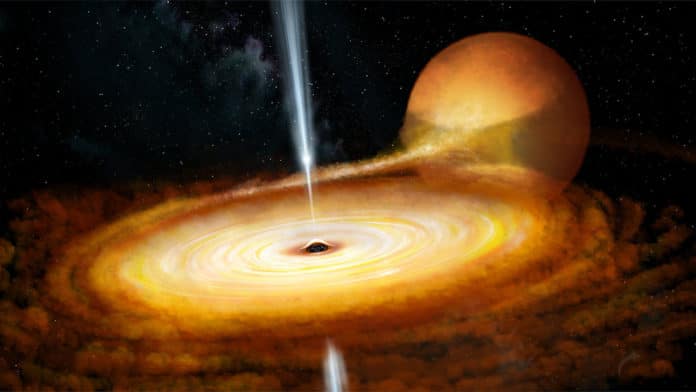Using state-of-the-art cameras, a team of international astronomers, including from the University of Southampton has created a movie of a growing black hole system at a level of detail never seen before. While doing this, scientists also revealed new intimations to understanding the surroundings of these enigmatic objects.
For this study, scientists studied the black hole system called MAXI J1820+070 that was first discovered in early 2018. Located about 10,000 lightyears away, in our own Milky Way, it has a mass of about 7 Suns.
This radiation was detected in visible light by the HiPERCAM instrument on the Gran Telescopio Canarias (La Palma, Canary Islands) and in X-rays by NASA’s NICER observatory aboard the International Space Station.
Usually, it is quite difficult to explore these systems, as their distances make them too faint and too small to see. Using HiPERCAM and NICER instruments, scientists managed to record movies of the changing light from the system at over three hundred frames per second. They even have captured violent ‘crackling’ and ‘flaring’ of visible and X-ray light.
John Paice, a graduate student at the University of Southampton, said, “The movie was made using real data, but slowed down to 1/10th of actual speed to allow the most rapid flares to be discerned by the human eye. We can see how the material around the black hole is so bright, it’s outshining the star that it is consuming, and the fastest flickers last only a few milliseconds – that’s the output of a hundred Suns and more being emitted in the blink of an eye.”
Scientists also detected that the dips in X-ray levels are accompanied by a rise in visible light (and vice-versa). And the fastest flashes in visible light were found to emerge a fraction of a second after X-rays.
Such patterns indirectly reveal the presence of distinct plasma, extremely hot material where electrons are stripped away from atoms, in structures deep in the embrace of the black hole’s gravity, otherwise too small to resolve.
Previously, Dr. Poshak Gandhi from the University of Southampton found a similar kind of split-second difference between X-ray and visible light has been seen in two other systems hosting black holes.
Dr. Gandhi noted, “The fact that we now see this in three systems strengthens the idea that it is a unifying characteristic of such growing black holes. If true, this must be telling us something fundamental about how plasma flows around black holes operates.”
“Our best ideas invoke a deep connection between inspiralling and outflowing bits of the plasma. But these are extreme physical conditions that we cannot replicate in Earth laboratories, and we don’t understand how nature manages this. Such data will be crucial for homing in on the correct theory.”
The study is published in the journal Monthly Notices of the Royal Astronomical Society: Letters.
